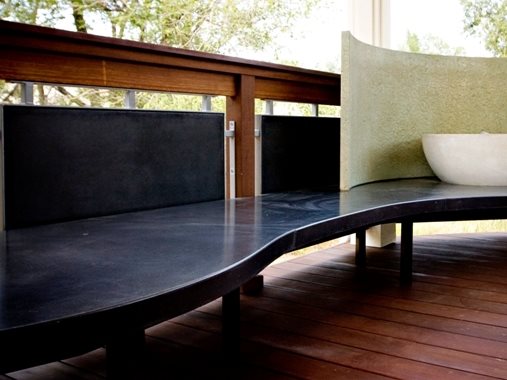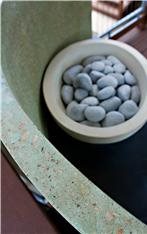- Concrete Furniture Home
- Concrete Furniture Photos
- Concrete Furniture Types
- Concrete Coffee Tables
- Outdoor Concrete Furniture
- Concrete Office Furniture
- Concrete Storage Furniture
- Concrete Ping Pong Tables
- Design Ideas
- Concrete Furniture Design Ideas: Behind-the-scenes info and photos
- Free Concrete Furniture Catalog
- Related Information
- Learn How to Make Bent Concrete Furniture
- Concrete Contractors: Find GFRC Mixes for Precast Concrete
Concrete Bench and Fire Bowl Create a Zen-Like Retreat
How do you give an outdoor deck in Boulder, Colo., the tranquility of a Japanese tea garden? Fiddlehead Designs of Denver used the transformational powers of concrete to bring a touch of the Orient to the Rocky Mountain state.
The backyard retreat is a 2,000-square-foot addition to an existing deck. The space was expanded to include an outdoor kitchen, dining area and sitting corner (where the bench is located), with the goal of creating distinctive areas with different purposes.
"Our clients have a background in interior design, so we worked very closely with them on creating a space that reflected their aesthetic style and incorporated the functionality they needed," says Aaron Graybill of Fiddlehead. "Aesthetically the client was going for a Japanese tea garden feel while still blending with the exterior architecture of the house, which is a traditional colonial style with clapboard siding. They wanted to use a lot of natural materials in their raw form, letting the character of the material speak for itself."
Naturally, concrete was high on their list because of its ability to be customized while retaining its natural qualities. "Concrete was really the only material that could be used and still maintain the minimalism the clients were after," says Graybill.
The concrete elements custom crafted for the project include an elevated curvilinear bench, a fire bowl partially inset into one end of the bench, and a pale green tea-stained firewall curving around the bowl. Framing the sitting area are four 2x3-foot concrete panels set into metal railings. All the concrete pieces were formed and cast in Fiddlehead's shop and assembled onsite.
| Product Review: Pro-Seal's Ultra Shield II-A |
| Environmentally Friendly Sealer Excels in High-Performance Applications. Read about Pro-Seal's Ultra Shield II-A. |
The fire bowl, which burns natural gas, is in the shape a Japanese teacup. "This is the first natural-gas fire bowl we've done, but it would work well on most wood decks because it's elevated off the deck, and the concrete is a noncombustible barrier," says Graybill. (Learn more about designing outdoor concrete fire features.)
The firewall was curved to wrap around the bowl and echo the curve of the bench. "The interesting thing is that this firewall was an afterthought driven more by fear of an open flame, a wood deck, and unpredictable building inspectors. But in retrospect, we all feel that the wall is what really makes the design," Graybill explains.
The charcoal-gray concrete bench is 2 inches thick, 13 feet long, and rests on slender legs of square steel tubing. It was designed to fit in a corner of the deck that is hexagonal in shape. The curvilinear shape of the bench helps to soften the geometry of the space.
"The bench shape is skinnier on the left side and widens where the fire bowl is set in the bench," says Graybill. "It was important to our clients that the bowl be oval, so the bench shape followed that. To get the bowl to sit in the bench, we cast plaster of Paris in the bottom of the bigger fiberglass mold we used to cast the bowl, and then used that as the hole knockout in the bench. This gave us a perfect replica hole in the bench of the underside of the fire bowl."
About 2 inches of the bowl protrudes through to the underside of the bench. "The weight of the concrete bowl and the incredibly snug fit in the void we cast in the bench hold it in place very securely. The firewall is fastened to the bench using silicone caulk and Tapcon screws," Graybill explains.
Coloring and finishing techniques
A yin-and-yang color scheme enhances the Zen-like mood evoked by the various concrete elements. The light green firewall is the focal point, enhanced with brown color variations created by a natural tea stain.
"Getting the color of the firewall right was a challenge," says Graybill. "The client had used tile for the cabinetry in the outdoor kitchen and wanted to match the color in the wall. The tile coloring was pretty complex, with a light tan undertone and a slightly striated blend of green and brown. Through a lot of experimentation with acid staining and tea staining we were able to get it extremely close."
The firewall was cast with no pigment—just white portland cement and fly ash. Fiddlehead then stained the wall with Blush-Tone acid stain from Brickform in a jade color and applied a natural black-tea wash.
For the bench, concrete panels and fire bowl, Fiddlehead used integral powdered pigments from Blue Concrete. The deep gray of the bench and panels was achieved with a carbon black pigment, and the porcelain tone of the fire bowl was produced by adding a titanium-white pigment to white portland cement.
To seal and protect the concrete, Fiddlehead used Pro-Seal Ultra Shield II-A from Pro-Seal Products. (Read more about Ultra Shield II-A.) "It provides the best balance between the stain resistance of a topical sealer and the look and feel of a penetrating sealer. It also has zero VOCs and is water-based, which is pretty important to us," says Graybill.
Before applying the sealer, Fiddlehead dry polished the concrete with a pneumatic sander and medium-grit sandpaper. However, achieving a flawless finish wasn't the goal. "On this project the more character, such as bugholes and mottling, the better," says Graybill.
Project submitted by:
Aaron Graybill, Principal
Fiddlehead Designs
2505 W. Second Ave., Unit 5
Denver, CO 80219
Phone:(303) 777-0374
www.fiddleheadconcrete.com
Get notified when new projects are added to ConcreteNetwork.com - Free monthly email
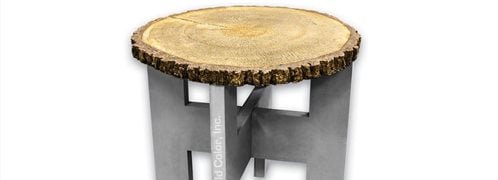 Urethane Furniture Molds
Log tables, benches and more
Urethane Furniture Molds
Log tables, benches and more
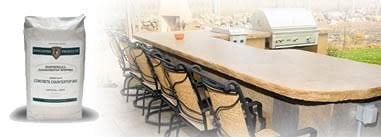 Imperial Mix
Lightweight, strong, minimal shrinkage
Imperial Mix
Lightweight, strong, minimal shrinkage
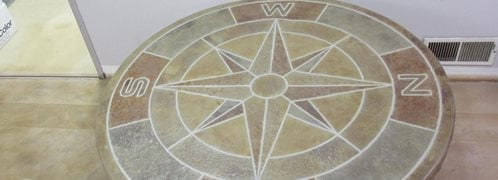 Table Top Molds
Live edge, compass, flags, checkboard, etc.
Table Top Molds
Live edge, compass, flags, checkboard, etc.
